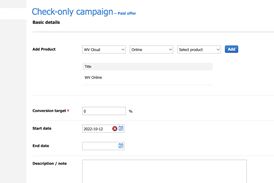All Webvision content management articles – Page 5
-
User guides
Resource search widget
The resource search widget is intended to provide the user with an easy and intuitive way of searching for a specific type of content.
-
User guides
Sharing content across brands
Where clients have more than one website with some crossover of readership, there are obvious benefits to promoting content from one site on another. This can be done easily in two ways – by copying content in the CMS from one brand to the other and editing as required, or ...
-
How-to guides
How to create RSS feeds of article content
RSS feeds can be used in various ways, whether it is to share content between related brands, or to supply content to third parties. Webvision Cloud allows you to easily configure RSS feeds and to use SPIN functionality to set the criteria for which content is included.
-
Release notes
WVC release notes – February 2019
Native advertising, widgets in story RHC, WhatsApp integration, Most popular bookmarks widget, My bookmarks widget, Comment restriction based on BI queries, GDPR improvements.
-
-
User guides
Story editing - teaser/intro, standfirst, storytext and access denied fields
The editor includes four text fields that are displayed on the website in different circumstances – on SPIN/landing pages, on story pages, on the story page access denied view, and in rss feeds.
-
Release notes
WVC release notes – November 2018
HTML support in SPIN intro fields, multi audio/video layout support on story and SPIN, improved security.
-
WVC UI framework
Platform cookies
The following document contains an audit of the cookies utilised by the Abacus platform.
-
Release notes
WV release notes – October 2018
Release notes for October 2018. Fixes and details of upcoming features.
-
Release notes
WV release notes – September 2018
Webvision Content API v2.0, Lazy loading images, PNG to JPG conversion for photographs on upload, SPIN – display images on/off, CMS story search improvements, Story edit – right-click insert paragraph, AJAX search – facets design.
-
User guides
Webvision Content API v2.0
The content API provides an interface to support the implementation of multiple non-Abacus applications.
-
Release notes
WV release notes – August 2018
Includes new “Hot Topics” navigation, one-off bylines, story search by ID and tags, microsite support for “mega menu content” asset.
-
Release notes
WV release notes – May 2018
Navigation spin block, exclude from search option, events improvements, viewing category details on CMS spin block criteria.
-
Release notes
WV release notes – April 2018
Full width story layout, SPIN individual stories, website option for contacts, etc.
-
User guides
Set up cookie policy
By law, site visitors and users must give their consent for cookies to be placed on their machine.
-
User guides
Webvision Content API v1.0
The content API provides an interface to support the implementation of multiple non-Abacus applications.
-
WVC UI framework
Previous issues/issue index
If configured, this optional page is linked to the A-Z subjects and authors pages and lists story content grouped issue. If applicable, cover images can be attached to each of the issues.
-
WVC UI framework
A–Z subjects and authors
These two linked pages build automatically as new content is added and categorised or given byline credits. They provide links to all stories with the selected category or byline.
-
User guides
Administrator tasks
A number of system level CMS options are restricted to administrator or manager users. They include site defaults, creating users, change tracking, activity reports and language translations.















